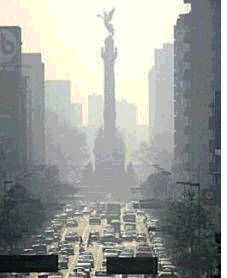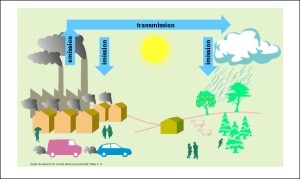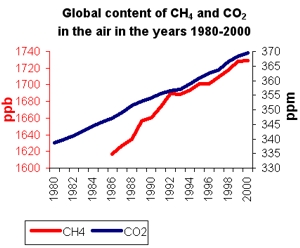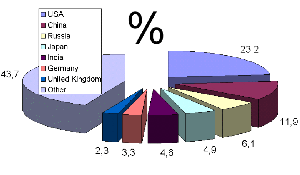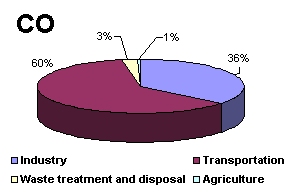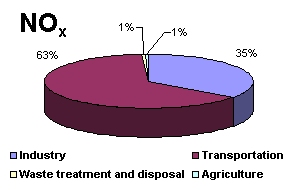 > ENC Master > Climate Encyclopaedia > Climate in Cities > basics > 1. Air Pollution > - Causes
> ENC Master > Climate Encyclopaedia > Climate in Cities > basics > 1. Air Pollution > - Causes
 |
|
|
|
Climate in citiesBasics |
Causes of anthropogenic air pollutionMost of the anthropogenic air pollution enters atmosphere due to combustion of fossil fuels in power plants, industry and transportation. However, in the cities of the developed countries, transportation emissions are the main air pollutants. |
Sources of anthropogenic air pollutionThe basic process during which anthropogenic air pollution is emitted is the combustion of fossil fuels in power plants, both organised and individual heating systems and vehicular traffic. The air pollution is emitted also by industry and by agriculture.
|
|
At the beginning of human civilisation, only the smokes from fire-places were the anthropogenic sources of air pollution. However, the importance of the problem gradually increased. Already in 1273, the king of England Edward I forbade to use coal in London as it caused enormous air pollution. |
In the 20th century, the dynamic development of industry and services caused high concentration of various institutions and factories in urban and industrialised areas. It was accompanied with the significant increase of the number of habitants, cars and buildings which also concentrated there. Vehicular traffic is of special importance in the cities where the density of streets and roads is much higher than in the non-urban areas. In many cities of the developed countries traffic nowadays is the most important source of air pollution. All the mentioned factors worsen the living conditions in towns and cities. Moreover, the urban air pollution contributes to the problem of intensified greenhouse effect and global warming.
|
|
Units While emissions are usually given in large amounts (e.g. thousands tonnes per year) and divided into sources and areas of origin, the immisions, or the concentrations in the air are usually given in much smaller units like µg/m3 of the air, and we talk about concentrations for the whole Earth, like in case of carbon dioxide (CO2), or for a given place and time, e.g. sulphur dioxide (SO2) in London in December 1952. Global content in the air (mixing ratio) is usually expressed in ppm (parts per million) or ppb (parts per billion). More about mixing ratio in the part "Higher atmosphere" (Basics, Undestanding the stratosphere, Composition). |
|
Anthropogenic emissionsAs explained in the part "What is air pollution?", some emissions have global impact on climate, while others only a local impact. Main areas with high air pollution due to human activity are: east coasts of USA and Canada, Europe, south and south-east Asia, and south-east Australia. They are also known for high air pollution emission. The emissions of sulphur dioxide (SO2) and nitrogen oxides (NOx) are discussed in the part about acid rain. Other pollutants emitted in large quantities which are significant for climate system functioning are carbon dioxide (CO2) and Volatile Organic Compounds (VOCs); CO2 and some of the VOCs (e.g. methane and CFCs) are greenhouse gases. The emissions of VOCs are presented in the part concerning impact of industry on air pollution. The table and the charts (Fig. 5) show air pollution emissions in chosen countries. The emissions vary a lot, due to many reasons, explained below for CO2 as an example.
|
Values in the table are expressed in thousands of tonnes.Click on the icons below to see the data from the table in the charts! |
|
Emission of air Emission of CO2 Emission of air |
5. Air pollution emissions in chosen countries
|
Example:
|
|
Emissions by continents By continents and regions, Asia with Australia and Oceania emit one third of world's CO2, and North America's emissions make further 28%, so those two regions produce almost 60% of global CO2 emissions. However, even though both regions emit almost the same amount of CO2 per year, the causes are quite different. About 3 882 million people live in Asia, Australia and Oceania, which is 61% of world's population, but only 5% of the population (about 400 million people, data for the year 2000) live in North America (meaning here USA, Canada and Mexico). While in Asia, Oceania and Australia the reason of high emission is large amount of people living there, in North America the reason is a very high consumption of energy in various forms. |
A closer look at the emissions by continents Figure 7 presents which country in every continent or region emits most CO2. For example, 46% for USA means that USA emits 46% of the whole North America's emission. Totally, 33% of world's population live in those 7 countries, but they emit as much as 51% of world's CO2 emissions (3352 million tonnes of carbon equivalent). However the emissions per capita are very differentiated (see Figure 9). |
|
|
Emission by countries Figure 8 shows countries which emit the largest amounts of CO2 in the world, for example 23.2% for USA means that this one country emits 23.2% of the whole world's emission. As we can see, some coutries from figure 7 appear again, but some do not. United States, China and Russia emit together over 42% of CO2 global emission, although only 27% of world's population live there. Among the 7 largest world's emittors there are no countries from Southern Hemisphere; three of them are in Europe, three in Asia and one in North America (note that Russia is both in Europe and Asia, but is usually included to European countries).
|
Emission per capita Figure 9 shows how much CO2 is emitted in chosen countries per person, for example it is 19.7 tonnes per one citizen of USA, while in India it is only 1.1tonnes. Such huge differences are the result of various levels of economic development. The more comfortable life (e.g. usage of cars, air conditioning, various electric home appliances etc.) , the more energy it takes, and the larger CO2 emission due to higher energy production. |
|
Anthropogenic emissions by sectorsAnthropogenic air pollution comes from many sources. Usually one source emits many kinds of pollutants. But we can also see that some human activities, e.g. transportation, are decisive for certain pollutants, i.e. they are mainly responsible for a certain pollutant emission. The data from UNECE/EMEP (United Nations Economic Commission for Europe/Co-operative programme for monitoring and evaluation of long range transmission of air pollutants in Europe) show which sectors of economy (i.e. what kinds of human activity) were mainly responsible for emissions of carbon monoxide (CO), nitrogen oxides (NOx) and sulphur oxides (SO2) in Europe, in 2001. The emissions are expressed in an SI unit Gg; 1 Gg = 1000 tonnes.
|
Carbon monoxide (CO)In Europe, in 2001, 30 679 Gg of CO was emitted. The main source of anthropogenic CO in the air was transportation (60%), and the industry contributed to 36% of the total emission. Waste management and agriculture were of marginal importance. More about CO emissions in the part "Lower atmosphere" (Basics, Greenhouse, Fire). |
|
|
Nitrogen oxides (NOx)Transportation was also the main source of NOx as it delivered 63% of the total emission which amounted 10 056 Gg in 2001. Industry contributed to 35% of the total emission. Again, emissions from waste management and agriculture were of marginal importance. |
Sulphur oxides (SOx)Unlike in the case of CO and NOx, the main source of SOx emissions was industry. It delivered 93% of the total emission of SOx in 2001, and the total emission amounted to 5 949 Gg. All other sectors delivered the remaining 7%. |
|
|
Emissions in citiesFor every city, both main emission sources and main air pollutants may be a bit different. It depends on such things as: what kind of industry is located there, how intensive the traffic is, what kinds of heating systems are used etc. Air pollution in cities is delivered to the atmosphere by low emission sources (e.g. individual heating systems in houses), high emission sources (e.g. high factory chimneys) and mobile sources (cars, buses). For example: Cracow is a medium-size city in southern Poland (800 000 habitants), with developed heavy industry (a steel-work, a huge power plant) and intensive traffic. Industry delivers almost whole amount of sulphur dioxide (SO2), and as much of carbon monoxide (CO) as transportation, but much more nitrogen oxides (NOx) and dust. Other sources of air pollution are of marginal importance. However, in many cities of West Europe, transportation is the main source of such air pollutants as CO or NOx, because heavy industry was moved away or replaced with new, clean technologies.
|
14. Emission of carbon monoxide (CO), nitrogen oxides (NOx) and dust by sectors in Cracow, Poland, in 2001.
|
|
Related pages: The air pollution is emitted also by industry and by agriculture. Read more about it in: |
|
About this page:Authors: Pawel Jezioro, Anita Bokwa - Jagiellonian University - Cracow / Poland |


